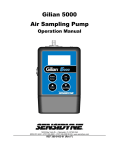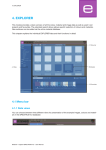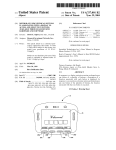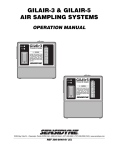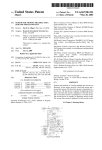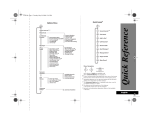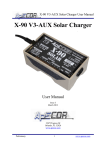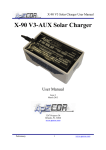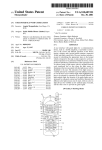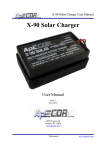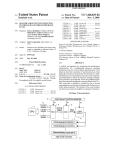Download Method and system of programming at least one appliance to
Transcript
US006112127A United States Patent [19] [11] Patent Number: Bennett [45] [54] Date of Patent: METHOD AND SYSTEM OF 5,086,385 2/1992 Launey et al. ........................ .. 364/184 5,187,655 5,218,552 2/1993 Post et al. 6/1993 Stirk et al. THE OCCURRENCE OF A TRIGGER EVENT 5,270,915 _ Inventor. . . . 8/1993 2/1995 574127291 . 5,457,478 Ishikuro et al. ...................... .. 364/191 Caci .......... .. 700/15 5/1995 Payne et al 10/1995 Frank 345/158 ....... . . . .. 5,565,843 “V1996 MeYViS' Estates, 111- 5,600,311 5,838,563 5,940,296 5,956,025 [22] Filed: 5,963,446 10/1999 Klein et al. NOV. 30, 1998 5,963,886 340/825.19 Dove et al. .. App], No_; 09/201,296 340/545 34O/82519 2/1997 Rice et al. 11/1998 [21] RltdU.S.A l' t' Dt ea e pp lea Ion a a 364/146 340/28601 12/1993 Tomita et al. ........................ .. 318/102 5,392,223 Raymond W. Bennett, Naperville, Ill. [73] Ass1gnee: Amerltech Services, Inc., Hoffman [63] Aug. 29, 2000 PROGRAMMING AT LEAST ONE APPLIANCE TO CHANGE STATE UPON 5,237,305 [75] 6,112,127 ..... .. 700/18 8/1999 Meyer ........... .. 9/1999 Goulden et al. 700/83 700/83 700/18 10/1999 Candy et al. ........................... .. 700/83 Primary Examiner—Paul P. Gordon Continuation of application No. 08/746,115, Nov. 6, 1996, Pat, No, 5,877,957, Assistant Exammer—RameSh_Pate1 _ _ Attorney, Agent, or Fzrm—Br1nks Hofer Gilson & L1one [51] Int. Cl.7 ................................................... .. G05B 19/42 [57] [52] US. Cl. ............................... .. 700/86; 700/12; 700/16; ABSTRACT . . . . 700/83_ 700/87_ 700/262_ 700075 340/286~01_ An automation system for programming appliances havmg ’340/286’11_ 345/1’58_ 345/1’62_ 345/166? programmable controllers, programmable devices and trig ' ’ ’ ’ 345/169’ , [58] Fleld of 8535313 720 305 3’40/é86 ’01 ’286’11 ’286 i4 2526 19’ 286 ’25_ 345/153 ’ 158 ‘162 16'3 166 ' [56] ’ ’ ’ ’ ’ 4’748’552 programmable controller in its training mode, activating the trigger device to generate a trigger signed and places select programmable devices in their programmed state. After all ’ References Cited 4 104 976 ger devices that communicate over a communication link. The user programs the programmable devices by placing the of the desired programmable devices have been put in then programmed states, the user takes the programmable con troller out of its training mode. When the programmable controller is out of its training mode, it monitors the com U.S. PATENT DOCUMENTS 8 1978 L d J 1 52988 8:21:11’ I‘ et a ' """"""" " """"""""""""""" 112 101 11 munication link for the trigger event. Upon detecting the 3/64/1'48 trigger event, the programmable controller sends messages 4’797’568 1/1989 Gumb 4,808,841 2/1989 Ito et al. ......... .. 307/141 to the selected programmable devices instructing them to go 307/141 to the“ Programmed State 4,899,129 5,043,531 2/1990 MacFadyen etal. . 340/310 R 8/1991 Gutenson et al. ...................... .. 174/49 29 Claims, 13 Drawing Sheets s4 IS PROGRAMMABLE CONTROLLER OUT CONTROLLER IN TRIGGER EVENT DETECTED‘7 EVENT DETECTED? 68 RECORD TRIGGER EVENT IN PROGRAMMABLE CONTROLLER RECALL PROGRAM STORED IN PROGRAMMABLE CONTROLLER BROADCAST PROGRAM STORED FOR TRIGGER EVENT DETECTED BROADCAST MESSAGE DETECTED’) RECORD BROADCAST MESSAGE IN PROGRAMMABLE BROADCAST MESSAGE DETECTED7 CONTROLLER 78 IS PROGRAMMABLE IGNORE BROADCAST MESSAGE MESSAGE HAVE INSTRUCTIONS FOR CONTROLLER OUT OF TRAINING MODE? YES 52 TFRMINATE PROGRAMMING 1 RECEIVE INSTRUCTION S U.S. Patent Aug. 29,2000 Sheet 1 0f 13 V 16 Fig. l / “(a 6,112,127 U.S. Patent Aug. 29,2000 Sheet 5 0f 13 6,112,127 PROGRAMMABLE CONTROLLER IN (FIG 5) TRIGGER EVENT DETECTED? RECORD TRIGGER EVENT IN PROGRAMMABLE CONTROLLER I BROADCAST MESSAGE DETECTED? RECORD BROADCAST MESSAGE IN PROGRAMMABLE CONTROLLER IS PROGRAMMABLE CONTROLLER OUT OF TRAINING MODE? 62 TERMINATE PROGRAMMING U.S. Patent Aug. 29,2000 Sheet 6 0f 13 PROGRAMMABLE 6,112,127 N0 CONTROLLER OUT (F IG- 4) OF TRAINING TRIGGER EVENT DETECTED? 68 / RECALL PROGRAM STORED ' IN PROGRAMMABLE 5 CONTROLLER / BROADCAST PROGRAM STORED FOR TRIGGER EVENT DETECTED BROADCAST MESSAGE DETECTED? 78 BROADCAST MESSAGE HAVE BRISKSSEST INSTRUCTIONS FOR PROGRAMMBLE MESSAGE 76 RECEIVE INSTRUCTIONS U.S. Patent Aug. 29, 2000 Sheet 7 0f 13 12' 6,112,127 12" \ 100* \ / /-11O /'110 100 ~\\/ 0 / /‘110 100“ \A o :l/ / 20'\ \I/ Fig. 6 Fig. 7 DEPRESS TRAIN BUTTON TO BEGIN PROGRAMMING SUPPLY TRIGGER EVENT BY OPENING DOOR #1 " TURN ON LAMP #1 v TURN ON LAMP #2 I DEPRESS TRAIN BUTTON TO TERMINATE PROGRAMMING Fig. 8 r18" U.S. Patent Aug. 29,2000 Sheet 8 0f 13 6,112,127 DEPRESS TRAIN BUTTON TO BEGIN PROGRAMMING SUPPLY TRIGGER EVENT BY TURNING ON LAMP #1 " TURN OFF LAMP #2 Fig. 9 V TURN ON LAMP #3 DEPRESS TRAIN BU'ITON TO TERMINATE PROGRAMMING DEPRESS TRAIN BUTTON TO BEGIN PROGRAMMING SUPPLY TRIGGER EVENT BY TURNING ON LAMP #1 " TURN ON LAMP #2 I TURN ON LAMP #3 TURN OFF LAMP #1 DEPRESS TRAIN BUTTON TO TERMINATE PROGRAMMING Fig. 10 U.S. Patent Aug. 29, 2000 Sheet 9 0f 13 6,112,127 DEPRESS TRAIN BUTTON TO BEGIN PROGRAMMING SUPPLY TRIGGER EVENT BY TURNING SWITCH " Fig. I] TURN ON LAMP #1 TURN ON LAMP #2 TURN ON LAMP #3 DEPRESS TRAIN BUTTON TO TERMINATE PROGRAMMING DEPRESS TRAIN BUTTON TO BEGIN PROGRAMMING I SUPPLY TRIGGER EVENT BY DEPRESSING A PUSH BUTTON TURN OFF LAMP_#1 TURN ON LAMP #2 TURN OFF LAMP #3 I DEPRESS TRAIN BUTTON TO TERMINATE PROGRAMMING U.S. Patent I Aug. 29,2000 J 6,112,127 ,, nun _____. " g o___-_-—¢ n LL. 2/ ———* a 210 \ C9 202 / Sheet 10 0f 13 E1 \216 \214[3 \ 220 U.S. Patent Aug. 29, 2000 Sheet 11 0f 13 6,112,127 230 1 JULY 9,1996 232“ ALARM SETTING SET DAYLIGHT E] 4212 PM. A A HOUR MIN V 234 " V 240-\ \ 214 \74 /'COMFORT 74 \ECONOMY Fig. 15 Q U.S. Patent Aug. 29,2000 Sheet 12 0f 13 6,112,127 254 224 \ 224 Fig.17 U.S. Patent Aug. 29, 2000 6,112,127 Sheet 13 0f 13 256 g) TRAIN 258\ \ \ NEXT \ RESET 254 260\ Fig. 18 123456789012345678901234 MONDAY APRIL 1, 1996 9:15 AM. (MORE |NFORMAT|ON)>> IE! E 1 2 3 4 5 6 NO 0 YES (RED) (BLUE) Fig. 19 UU 6,112,127 1 2 METHOD AND SYSTEM OF PROGRAMMING AT LEAST ONE APPLIANCE TO CHANGE STATE UPON THE OCCURRENCE OF A TRIGGER EVENT The Echelon Corporation has built home automation and industrial control apparatus based on a signaling protocol This application is a continuation of application Ser. No. 08/746,115, ?led Nov. 6, 1996 now US. Pat. No. 5,877,957. ment in Which the individual nodes maintain their oWn programs. Programming of the individual nodes can be done TECHNICAL FIELD by doWnloading neW softWare from a temporarily attached lap top computer or by doWnloading softWare over the LonWorks netWork. A similar approach has been taken by they refer to as LonWorks that uses a netWork of nodes each of Which has one or more microprocessors. The system is designed to operate in a “cooperative computing” environ An automation system for controlling the behavior of an environment in response to certain events. CEBus and has been used in many custom installations for larger homes and office buildings. BACKGROUND OF THE INVENTION Currently, automation systems Which are used to control While such systems eliminate the central control unit, the behavior of an environment such as a home or office 15 building are programmed using either a simple command language or using a graphical user interface that requires a computer With a monitor. These systems are expensive and require substantial investment by the user in time and energy It is thus desirable to provide an automation system that is inexpensive, easily installed, and easily programmable and reprogrammable. It is also desirable to provide a home automation system that can be programmed and repro changes in existing programs of such systems a user must consult a user’s manual or call a programming specialist. grammed by a user having little or no knoWledge or expe The overall utility of the automation system is drastically rience in programming. It is also desirable to provide an automation system that alloWs the incorporation of neW and 25 as they are sometimes called, commonly provide for control of lighting, heating and air conditioning, WindoW shades or different, appliances and controllers Without the system becoming obsolete. SUMMARY OF THE INVENTION According to a ?rst aspect of the present invention there is provided a method of programming at least one appliance curtains, pool heaters and ?ltration systems, laWn sprinklers, ornamental fountains, audio/visual equipment, and other appliances. Home automation systems are frequently inte to change state upon the occurrence of a trigger event. The method includes the steps of providing at least one program mable devices coupled to the at least one appliance, provid grated With a home security system so that When a ?re alarm is raised, for example, internal and external lights Will be turned on. Security systems frequently include lighting system and usually requires the user to acquire relatively expensive hardWare and softWare and become pro?cient in the use of PC-based softWare. to install and modify programming. Generally to make reduced because the user ?nds it dif?cult to adapt the system to changing needs or to make additions, deletions or modi ?cations to the programs resident in such systems. Home automation systems, or home management systems modifying the softWare still requires the use of a PC-based 35 ing a programmable controller coupled to the programmable control and other types of home automation as an option. device Where the programmable controller and program Many larger homes incorporate a home theater Which mable device communicate With one another. The program requires a certain amount of automation for convenient operation and this automation is often extended to other mable controller has a training mode Which, When selected, parts of the dWelling. In farms, the automation system Will also control outbuilding heating and lighting and Warn of off normal conditions in automated feeding machinery and the grammed to change the state of the ?rst appliance upon the like. One form of automation system includes a central control unit that monitors environmental sensors and inputs from user controls and maintains a schedule of pre-programmed time-of-day and day-of-the Week events. Inputs to the cen event, and changes the state of the ?rst appliance from an alloWs the at least one programmable device to be pro occurrence of the trigger event. The user places the pro grammable controller in training mode, provides a trigger unprogrammed state to a programmed state. The user then 45 tral control are provided by dedicated loW-voltage Wiring, grammed state. for example, from door and WindoW sensors, signals carried on poWer lines, RF signals, signals on existing telephone According to a second aspect of the present invention there is provided a system of programming at least one Wiring and, occasionally, optical signals. The central control appliance. The system includes a programmable device coupled to at least a ?rst appliance Where the programmable device detects the state of the ?rst appliance, and a pro unit is controlled by a program that is either speci?cally built for the particular installation or a general-purpose program With a user interface that alloWs the oWner or a technician employed by the oWner to make certain types of modi?ca tions. The interfaces to these programs can be anything from strings of digits entered on standard touch-tone keypads, for example, Home Automation Inc.’s Omni Automation and takes the programmable controller out of training mode so that the ?rst appliance is noW programmed so that upon the next occurrence of the trigger event the ?rst appliance Will change states from its unprogrammed state to its pro 55 grammable controller coupled to and communicating With the programmable device over a communication link. The programmable controller has a training mode Which, When selected, alloWs the programmable device to be programmed Security System, to graphical user interfaces, for example, to change the state of the ?rst appliance upon the occurrence the Molex “Choices” softWare. While the graphical user interfaces can be relatively easy to use, they require the presence in the home of a personal computer and often require the system oWner to purchase additional hardWare and softWare. Systems that rely on touch tone keypads for input and one- and tWo-line LCD for display are less expensive, but generally require the user to of the trigger event. When the programmable controller is put in the training mode and a trigger event occurs, and the state of the ?rst appliance is changed and the programmable controller is taken out of the training mode, the ?rst appli remember or, more likely, lookup arbitrary commands. 65 ance Will change to its programmed state upon the next occurrence of the trigger event. According to a third aspect of the present invention there is provided a method for programming a home automation 6,112,127 3 4 system. The method includes the steps of providing pro grammable devices located throughout a home. Each pro grammable device is coupled to an appliance and each programmable device can detect the state of the appliance coupled to it. Providing a programmable controller located in the home and coupled to the programmable devices by a FIG. 3 is a block diagram of the programmable device shoWn in FIG. 1 according to a third preferred embodiment of the present invention. FIG. 3a is a block diagram of the programmable device shoWn in FIG. 1a according to a preferred embodiment of the present invention. FIGS. 4—5 are flow charts illustrating the communication communication link. The programmable controller has a training mode Which, When selected, alloWs selected pro grammable devices to be programmed to change the state of the appliance connected thereto. Programming selected appliances to change from an unprogrammed state to a protocol betWeen the programmable controller and program mable device according to a preferred embodiment of the 10 programmed state by placing selected appliances in their respective unprogrammed state, placing the programmable controller in the training mode, providing a trigger event, changing the states of selected appliances from their unpro grammed state to their programmed state and taking the programmable controller out of the training mode. The home 15 various program sequences. FIG. 13 is a of the Wiring and components schematic for a home automation system according to a preferred embodi ment of the present invention. 25 stored by the programmable controller, changing the state of the at least one appliance from an unprogrammed state to a programmed state, deleting the change of state of the at least one appliance, broadcasting a message over the communi cation link indicating that the programmed state of the at least one appliance Wherein the message is received and stored by the programmable controller, and taking the pro grammable device out of the training mode. The at least one appliance is programmed to go to its programmed state upon the occurrence of the trigger event. According to a ?fth aspect of the present invention there is provided a method for automating an environment. The 35 device coupled to a communication link, providing a pro DETAILED DESCRIPTION OF THE PRESENTLY PREFERRED EMBODIMENTS mable controller is coupled to the communication link Wherein the programmable controller and programmable FIG. 1 is a perspective vieW of an automation system 10 device communicate With one another over the communi 45 programmable controller in a training mode, activating the trigger device to generate a trigger signal, storing the trigger signal in the memory of the programmable control, placing according to a preferred embodiment of the present inven tion. In its simplest embodiment the automation system 10 includes a programmable controller 12, a programmable device 14, and a communication link 16 coupling the programmable controller 12 and the programmable device 14 so that they can communicate With one another. The programmable controller 12 has a user accessible control or the programmable device in a desired state, broadcasting a message that the programmable device is in the desired state, 55 train button 18 to place the programmable controller 12 in training mode and take the programmable controller out of training mode. Training mode refers to the state in Which the programmable controller 12 is in When it is being pro grammed. In a preferred embodiment the user accessible control 18 is a push doWn button Which places the program trigger event, detecting the trigger event, and broadcasting a control signal over the communication link to the program mable device to change to its desired state. mable controller 12 in training mode and When pushed again to release the button takes the programmable controller 12 out of training mode. The user accessible control 18 Will be referred to hereinafter as the “train button.” Optionally, the programmable controller 12 may also be equipped With an BRIEF DESCRIPTION OF THE DRAWINGS FIG. 1 is a schematic of an automation system according to a preferred embodiment of the present invention. FIG. 1a is a schematic of an automation system according to another preferred embodiment of the present invention. FIG. 2 is a block diagram of the programmable controller shoWn in FIGS. 1 and 1a according to a second preferred embodiment of the present invention. FIG. 17 is a schematic of a remote programmable light ?xture. FIG. 18 illustrates a front panel of a sequence interface according to a preferred embodiment of the present inven tion. FIG. 19 illustrates a front panel of a Whole house con grammable controller having memory, Wherein the program storing the message in the memory of the programmable controller, taking the programmable controller out of the training mode, monitoring the communication link for the FIG. 14 illustrates the front panel of a programmable clock according to a preferred embodiment of the present invention. FIG. 15 illustrates a front panel of a programmable thermostat according to a preferred embodiment of the present invention. FIG. 16 illustrates a front panel of a security interface according to a preferred embodiment of the present inven tion. troller according to a preferred embodiment of the present invention. method includes the steps of providing programmable cation link, providing a trigger device coupled to the com munication link Wherein the trigger device and program mable controller communicate With one another, placing the controller incorporated With a bank of sWitches according to a preferred embodiment of the present invention. FIG. 7 illustrates the front of a programmable controller incorporated With a bank of push buttons according to a preferred embodiment of the present invention. FIGS. 8, 9, 10, 11, and 12 are flow charts illustrating is noW programmed so that the neXt occurrence of the trigger event Will cause the selected appliances to change from their unprogrammed states to their programmed states. According to a fourth aspect of the present invention there is provided a method of programming at least one appliance. The method includes the steps of providing a programmable controller coupled by a communication link to the at least one appliance, placing the programmable controller in the training mode, broadcasting a trigger event over the com munication link Wherein the trigger event is received and present invention. FIG. 6 illustrates the front panel of a programmable indicator 20 such as an LED Which is illuminated When the 65 programmable controller 12 is in training mode and is extinguished When the programmable controller is not in training mode. The programmable device 14, Which Will be described in detail hereinafter, broadcasts messages to and 6,112,127 5 6 receives messages from the programmable controller 12 appliances such as sWitches, lamps, dishWashers, curtain controls, audio and video equipment, thermostats, laWnsprinklers, etc. over communication link 16. First a brief description of the operation of the automation system 10 Will be given followed by a detailed description of various preferred embodiments of the components of the automation system 10. The automation system 10 is pro FIG. 1a is a perspective vieW of an automation system 10‘ according to another preferred embodiment of the present invention. FIG. 1a is similar to FIG. 1 eXcept that the programmable device 14‘ is divided into a programmable outlet 17 and an appliance 19. In a preferred embodiment, the programmable outlet 17 is plugged into the poWer line grammed by demonstrating What should happen in response to a particular event. For example, if the automation system 10 is installed in a home, the programmable controller 12 is preferably mounted in a Wall of the home, for eXample, 10 Where the user Will have access to the train button 18. The programmable device 14 is also located in the home and the communication link 16 betWeen the programmable control broadcasts a message over the communication link 16‘ that ler 12 and the programmable device 14 is provided by the poWer lines in the home. If the user Wants the programmable and provides a socket into Which an appliance 19, such as a lamp, can be plugged. The programmable outlet 17 detects a change in state of the appliance coupled thereto and 15 device 14 to go to a programmed state upon the occurrence the appliance 19 has changed states. While a lamp is shoWn as the appliance in this preferred embodiment, the present invention is not limited to such appliances but includes other of a particular event, ie a trigger event, the user ?rst places appliances such as sWitches, dishWashers, curtain controls, the programmable controller 12 in its training mode by audio and video equipment, etc. The term appliance is used depressing the train button 18, and then causes a trigger signal Which Will be described hereinafter, that is received by programmable controller 12 over the communication link broadly to encompass any device that can change its state at 16. The user then Walks over to the programmable device 14 he or she Wishes to be controlled by the trigger event and ence to FIGS. 1 and 1a have the poWer lines of a home least from one state to another. While the particular embodiment described With refer establishing the communication link 16, the present inven tion is not limited to such a communication media. Other 25 media may be used such as RF transmissions, messages over dedicated Wiring, messages sent as data over phone lines programmed state may be turning the lamp on. The user then puts the programmable device 14 in the desired programmed state. For eXample, if the programmable device is a lamp, the using frequencies not used by voice signals, optical signals, Walks back to the programmable controller 12 and takes it out of its training mode using the train button 18. NoW the automation system 10 is programmed so that upon the neXt occurrence of the trigger event, the programmable device 14 Will go to the desired programmed state. Adetailed descrip tion of the communications over communication link 16 Will be described hereinafter. The trigger event can be generated in numerous Ways. For eXample, as Will be seen hereinafter, programmable devices 14 frequently generate messages Which can be regarded as etc. In addition, While only one programmable device 14 is shoWn in FIGS. 1 and 1a, a plurality of programmable devices can be provided to communicate With one or a plurality of programmable controllers 12 all coupled by communication link 16. Later, a description of preferred 35 embodiments of the present invention applied to a home automation system Will be described. FIG. 2 is a block diagram of the programmable controller 12 shoWn in FIGS. 1 and 1a according to a preferred embodiment of the present invention. The programmable trigger events by the programmable controller 12. In operation, the programmable controller 12 can receive a controller 12 includes a transceiver 22, a microprocessor 26 number of messages that might be trigger events and other messages that might be generated by the user putting pro grammable devices 14 into their programmed state. The trigger event is selected as the event Which generated the ?rst message received by the programmable controller after preferably having both RAM memory 28 and ROM memory 30 and train button 18. The microprocessor 26 is coupled to the transceiver 22 Which in turn is coupled to the commu nication link 16. The transceiver 22 receives messages from the communication link 16 and sends messages over the communication link 16. The train button 18 is coupled to the it is placed in training mode. For example, if the trigger event is generated by an environmental sensor coupled to the communication link 16, the trigger event may be the detec 45 microprocessor 26 and places the programmable controller 12 either in or out of training mode. The programmable controller 12 has an address identi?ed With it Which may be stored in ROM 30 or alternatively, an address selector 32, tion of a movement in the ?eld of vieW of the sensor, the opening or closing of a door or WindoW, the detection of an controller 12 is in the training mode is the trigger event. Generally the trigger event can be any signal broadcast over communication link 16 to the programmable controller 12. coupled to the microprocessor 26, can be provided to alloW the address of the programmable controller 12 to be selected. FIG. 3 is a block diagram of the programmable device 14 shoWn in FIG. 1 according to a preferred embodiment of the present invention. The programmable device 14 includes a transceiver 34, appliance electronics 35, and a microproces sor 40 preferably having both RAM memory 42 and ROM memory 44. The microprocessor 40 is coupled to the trans ceiver 34, and appliance electronics 35. The transceiver 34 is coupled to the communication link 16 to receive and The trigger event is preferably the ?rst detected signal by the programmable controller 12 after it has been put in training mode. Various programming sequences and trigger events broadcast messages over the communication link 16. The programmable device 14 has an address identi?ed With it Which may be stored in ROM 42 or alternatively, an address Will be described hereinafter. The programmable device 14 illustrated in FIG. 1 is able selector 44, coupled to the microprocessor 40, can be provided to alloW the address of the programmable device alarm condition. The trigger event can also be generated by a programmable device Where the trigger event is the change of state of the programmable device. For eXample, the user may Want a second programmable device to go to a desired programmed state every time a ?rst programmable device goes to a particular programmed state. Putting the ?rst appliance in its programmed state after the programmable 55 14 to be selected. to broadcast messages over the communication link 16 indicating a change in its state and also receive signals over the communication link 16 to control its operation. The programmable device 14 includes but is not limited to 65 In the preferred embodiment illustrated in FIG. 3, the programmable device 14 is like that shoWn in FIG. 1 in Which it is integrated into the appliance itself. 6,112,127 7 8 FIG. 3a is a block diagram of the programmable device 14‘ shown in FIG. 1a according to a preferred embodiment of the present invention. The programmable device 14‘ includes a transceiver 34‘, a control relay 36, a load detector mable device(s) Will each have associated With it the pro grammable device’s unique address, preferably a byte or tWo in length, folloWed by a message. The message of the broadcast signal may specify that the device has been turned 38, and a microprocessor 40‘ preferably having both RAM on or off or that a particular percentage of energy is being draWn, for example. In addition, particularly for the embodi memory 42‘ and ROM memory 44‘. The microprocessor 40‘ is coupled to the transceiver 34‘, control relay 36 and load detector 38. The transceiver 34‘ is coupled to the commu nication link 16 to receive and broadcast messages over the communication link 16. The load detector 38‘ is coupled to an appliance 19 (see FIG. 1a). The programmable device 14‘ has an address identi?ed With it Which may be stored in ROM 42 or alternatively, an address selector 44‘, coupled to the microprocessor 40‘, can be provided to alloW the address of the programmable device 14‘ to be selected. 10 15 In the preferred embodiment illustrated in FIG. 3, the programmable device 14‘ is like that shoWn in FIG. 1a Which of the appliance coupled to the programmable device 14‘, ie the appliance begins draWing poWer or ceases draWing 25 ming that at the minimum expanded the message set de?n ing control of lighting from one that referred only to intensity to one that speci?ed color and intensity. In a preferred embodiment of the present invention a simpler and more general solution to the problem of adding neW devices to be controlled Without making any modi? 35 could be provided so that the user could use one control to adjust intensity and another control to adjust color of the indirect lights in a room. Using programming methods previously discussed, the user could then program the pro grammable controller to provide a soft “White” indirect light When a small table lamp Was turned on and to provide bright White light When a particular ?oor lamp Was illuminated. To 45 make this programming possible Without making any changes in the programmable controller, the neW lighting ?xture Would be a programmable device that Would broad cast a message to the programmable controller that con tained Within that message an instruction that should be sent back to the lighting appliance in order to duplicate the setting the user had selected from the control panel. The programmable controller stores the message that should be device. This cycle continues until the programming has been sent to the neW lighting ?xture, and in the future When the trigger event Was detected it Would direct the stored message 55 to the neW lighting appliance. The programmable controller doesn’t need to “knoW” anything about the operation of this neW programmable device and doesn’t even need to knoW it is a light. When the programmable controller 12 is out of its training mode, it monitors the communication link 16 for recogniZ able trigger events. FIG. 5 is a How chart illustrating the communications over communication link 16 When the receive more than one broadcast message. In particular, according to a preferred embodiment of the present invention, the trigger signal Will have associated With it a unique identi?er Which Will be recorded by the program mable device 12. The message(s) broadcast by the program cations of the existing system components exists. For example, in the case of a lighting appliance that alloWs the user to adjust both color and intensity, a user control panel over the communication link 16. If a message is detected, terminated. The recording of the trigger event and broadcast messages by the programmable controller creates a program stored by the programmable controller 12. Of course many programs formed by trigger events and the broadcast messages asso ciated thereWith can be stored by the programmable con troller. In FIGS. 1 and 1a only one programmable device 14 is shoWn, hoWever, it is to be understood that a plurality of programmable devices can be coupled to the communication link 16 in Which case the programmable controller 12 may intensity of a programmable light ?xture (on, off and various dimming levels), but also the color of the light. For existing automation systems, in order to add color control it Would be to block 64 shoWn in FIG. 5. If it has then control is passed to block 52 Where it is determined Whether a trigger event has been detected over the communication link 16. If a control is passed to block 58 Where the broadcast message is recorded in the RAM 28 of the programmable controller 12. If a broadcast message has not been detected, the programmable controller 12 Waits for a broadcast message. After a broadcast message has been detected and recorded, control is passed to block 60 Where it is determined Whether the programmable controller 12 has been taken out of training mode. If it has, control is passed to block 62 and the programming is terminated. If not, control is passed back to block 56 Where the programmable controller 12 Waits for another message to be broadcast by another programmable knoW anything about the con?guration of the programmable necessary for system controllers to receive neW program has been put in training mode. If it has not, control is passed trigger event has been detected, that trigger event is recorded in the RAM 28 of the programmable controller 12 in block 54. If a trigger event has not been detected, the program mable controller 12 Waits for the detection of a trigger event. After the trigger event has been detected and recorded, control is passed to block 56 Where it is determined Whether a message has been broadcast by a programmable device 14 of training mode. This is particularly useful When the programmable device 14 is like that shoWn in FIG. 1 because the programmable controller 12 does not have to device 14. The programmable device 14 provides its oWn instruction in the message it broadcasts to the programmable controller. This alloWs the automation system 10 to easily accom modate neW types of appliances and controllers. For example, suppose that at some future time it became popular to install lighting Where the user could control not only the includes an outlet that is plugged into the poWer line and provides a socket into Which the appliance 19, such as a lamp, for example, can be plugged into. In such an embodiment, the load detector 38 detects a change in state poWer or the amount of poWer the appliance is draWing. The communication betWeen the programmable control ler 12 and the programmable device Will noW be described With reference to the How chart shoWn in FIG. 4. At block 50 it is determined Whether the programmable controller 12 ment shoWn in FIG. 1, the message includes instructions Which Will be broadcast back to the programmable device to cause it to mimic the action that Was just taken. This message Will be broadcast back to the programmable device by the programmable controller upon the next occurrence of the trigger event When the programmable controller 12 is out 65 programmable controller 12 is out of its training mode. At block 64 it is determined Whether the programmable con troller 12 is out of its training mode. If it is not, control of the program is transferred to block 50 as shoWn in FIG. 4. If it is, control is passed to block 66 Where it is determined Whether a trigger event has been detected. If one has not, 6,112,127 9 10 control is returned to block 66 Where the programmable controller 12 Waits for the detection of a trigger event. Once a trigger event has been detected control is passed to block 68 Where the program stored in the RAM 28 of the pro to program all of the lamps to turn on based upon the occurrence of a trigger event, the user performs the folloW ing sequence: press the train button 18‘ to place the programmable grammable controller 12, associated With the particular controller 12‘ in its training mode to commence pro trigger event detected, is recalled. Then at block 70, the program stored in RAM 28 of the programmable controller gramming; supply a Type I type trigger event (i.e., depress one of the bank of sWitches 100) 12 is broadcast over communication link 16. The program mable devices 14 coupled to the communication link 16 listen for broadcasted messages. At block 72 each program mable device 14 coupled to communication link 16 detects 10 turn lamp 1 on; turn lamp 2 on; Whether a message has been broadcast. Control is then turn lamp 3 off; and passed to block 74 Where it is determined Whether the program broadcast includes any message for particular pro grammable devices. If it does, control is passed to block 76 deactivate the user control to take the programmable controller out of training mode to conclude program Where the programmable devices detect this by matching 15 ming. NoW, upon the next occurrence of the trigger event When their unique address With the addresses in the broadcast the programmable controller is out of its training mode, program. If it recogniZes its address, the programmable lamps 1, 2 and 3 Will all turn on. The actual state of the device receives its designated message in the program and executes the instructions associated With that message. If not, control is passed to block 78 Where the message is ignored. Each programmable device coupled to the commu nication link checks the program broadcast by the program appliances during programming is immaterial, the important feature is that the user touched the appliance during pro gramming regardless of Whether the appliance Was turned on or off The bank of sWitches 100 shoWn in FIG. 6 are particularly useful in such an application. The second type of programming, Which Will be referred mable controller to see if any of the messages contained therein are for it. Signaling protocols such as X-10 (a proprietary protocol to as “Type II” programming, associates discrete events With speci?c commands to be sent to the programmable devices. of the X-10 Corporation), CEBus (an EIA standard backed by an industry consortium) or Lon Works (a standard oWned and maintained by the Echelon Corporation) may be used programming is material. Thus, if the above sequence Was For Type II programming the state of the appliance during programmed using Type II programming, lamps 1 and 2 for the communication protocol over communication link 16. Would turn on and lamp 3 Would turn off upon the occur rence of the trigger event. The bank of push buttons 110 shoWn in FIG. 7 are particularly useful for Type II program The programmable controller may be incorporated into ming. more complex systems depending upon the particular appli cation to Which it Will be subjected. FIG. 6 illustrates a programmable controller 12‘ incorporated With a bank of sWitches 100 according to a preferred embodiment of the The determination of Whether Type I or Type II program 35 not limited to the particular examples given. Whether the programming is of Type I or Type II is inferred from the trigger event and from What programmable devices that are to be controlled by that trigger event. If the trigger event is supplied by an on/off sWitch and if the appliances to be present invention. FIG. 7 illustrates a programmable con troller 12“ incorporated With a bank of push buttons 110 according to a preferred embodiment of the present inven tion. The programmable controllers 12‘ and 12“ shoWn in FIGS. 6 and 7 respectively are particularly useful for tWo types of programming. A?rst type, Which Will be referred to as “Type I” programming, causes programmable devices coupled over a communication link 16 to the programmable controller and selected to be programmed to all go to the same state When the trigger event occurs. For the simplest ming is taking place is arbitrary and the present invention is controlled all have on and off states, it may be assumed that Type I programming is being performed. If the trigger event is supplied by a momentary contract device or the opening of a door, then it may be assumed that Type II programming 45 is being performed. If the trigger event is supplied by an appliance Whose state is reversible, the lamp can be turned either on or off, it may be assumed that either Type I or Type variety of Type I programming, all of the selected program II programming is being performed. In a preferred embodi mable devices have just tWo states, for example, on and off. The trigger event also has tWo states, for example, on and off. When the trigger event is put in its on state, all of the particular assumptions have been described linking certain ment it is assumed that the programming is Type II. While events to Type I or Type II programming, other embodiments, Which Would be obvious to those of ordinary skill in the art in light of the teachings of the present selected programmable devices go to their on state. When the trigger event is put in its off state, all of the selected programmable devices go to their off state. Of course, the programmable devices and trigger event may have more than tWo states. For example, suppose that the trigger event 55 mode. The programmable controllers and programmable devices according to the preferred embodiments of the present is supplied by a programmable dimmer sWitch and the selected programmable devices are light ?xtures attached to the programmable dimmer sWitch. For Type I programming, all of the lighting ?xtures Would respond to changes in the setting of the trigger dimmer in the same Way. The program mable devices and trigger event do not have to be identical in state but they do have to be congruent in the sense of having operational states that can be mapped onto each other. For example, suppose there are three programmable invention, may be implemented. In a preferred embodiment, the programmable controller decides the programming invention alloW a user to create a program by a simple, program by demonstration technique. No knoWledge of programming is needed and creating, modifying or deleting programs can be simply implemented by the user. The user simply physically demonstrates What is to occur upon the detection of a trigger event. 65 FIGS. 8—12 are How charts illustrating examples of steps devices 14‘ according to the preferred embodiment shoWn in used to program various sequences in response to various FIG. 1a Where each appliance 19 is a lamp. If the user Wants trigger events. It is assumed that the programmable control 6,112,127 11 12 ler and programmable devices are located in a home auto face 216, a security interface 218 and a security panel 220, mation system for all of the sequences shoWn in FIGS. 8—12. The sequence shoWn in FIG. 8 trains the house to turn Lamp1 on and Lamp2 off When a door is opened. The sequence shoWn in FIG. 9 causes Lamp 2 to be turned off and Lamp3 turned on Whenever Lamp1 is turned on. In this case turning Lamp1 on is the trigger event. The sequence shoWn in FIG. 10 programs the house to turn Lamp2 and Lamp3 on When Lamp1 is turned on. In a preferred embodi and a plurality of environmental sensors 222. As Will be described, all of these components communicate With one another preferably over the poWer lines 224 of the house in Which they are installed. The embodiment shoWn in FIG. 13 ment the last event, turning Lamp1 off, is ignored since for the purpose of this training sequence Lamp1 is a trigger the programmable controller 202 in and out of training mode. The plurality of programmable devices 204 are pref erably of the type shoWn in FIGS. 1 and 1a. Programmable controller 206 is preferably of the type shoWn in either FIG. is merely exemplary and the present invention is not limited to such an embodiment. The programmable controller 202 is preferably of the type shoWn in FIG. 1 Where it has a user access control 203 to put event and all trigger events subsequent to the occurrence of the ?rst trigger event are ignored. In other applications it may not be appropriate to ignore subsequent trigger events. 6 or 7. The sWitches 208 are preferably programmable so The sequence shoWn in FIG. 11 programs the home to turn 15 that they broadcast messages over the communication link 224 and receive messages broadcast over the communica Lamps 1, 2 and 3 on every time one of the bank of sWitches 100 shoWn in FIG. 6 is turned on. Because one of the bank tion Link 224. The programmable clock 210 broadcasts messages over of sWitches 100 Was used as the trigger event, it Was assumed that Type I programming Was implemented Which the poWer lines at certain signi?cant times, i.e., sunset, cause all of the selected appliances to go to the same state sunrise, and at times selected by the user. FIG. 14 illustrates the front panel of a preferred embodiment of the program as the trigger event regardless of their actual state during programming. Alternatively, the sequence shoWn in FIG. 12 programs the house to turn Lamps 1 and 3 off and Lamp2 on every time one of the push buttons 110 shoWn in FIG. 7 is depressed. Even though the same steps Were performed after the trigger event as occurred in FIG. 11, because one of the push buttons 110 of the programmable Was used as the trigger event it Was assumed that Type II programming Was implemented Which causes all of the selected appliances to go to their individual programmed states. As already mable clock 210. In the preferred embodiment, the program mable clock has a display 230 to display the current date and 25 alloWs the user to scroll through the events or intervals. The user can select particular events or intervals using the Set, Hour and Minute buttons. In a preferred embodiment, the programmable clock 210 includes a train button 236 so that programmable devices coupled over the poWer lines 224 can described the assumptions made With respect to Type I and Type II programming are arbitrary and the present invention is not limited to the particular examples given. be programmed based on events, i.e., sunrise; or intervals, i.e., night. For example, to program a lamp to turn on at These are but some of the programming sequences that can be implemented using the programmable controller and programmable devices according to the present invention. The present invention, hoWever, is not limited to these sunset, the user Would press the train button on a program 35 only When it Was dark out, the user might use the sequence: press train button on a programmable controller open the door press train button on the clock system has learned a response to a particular trigger event, to delete responses associated With that particular trigger event one need only put the programmable controller in the select the interval “night time” from the clock display training mode, supply the particular trigger event and then 45 and it is dark out press the train button on a programmable controller again Variations in this sequence could be de?ned by one skilled in the art to suit the needs of particular installations or types able to “start over,” the designer could elect to not imple ment the “erase all” function, to require the user to perform the “erase all” action tWice in succession before it took of users. effect, or even to provide a separate “delete” button that Was 55 can be incorporated into a larger system to support, for example, home automation. FIG. 13 is a schematic of the Wiring and components for a home automation system according to a preferred embodiment of the present inven tion. The automation system 200 preferably includes the programmable clock 210, a programmable light ?xture 212, a programmable thermostat 214 coupled to a HVAC inter Alternatively, the programmable clock need not have a train button to program appliances according to time. Instead, one can put another programmable controller in its training mode, select a time interval or event using the programmable clock as the trigger event, place selected programmable devices in their program state and take the programmable controller out of training mode to complete programming. Upon the next occurrence of the time interval or event used as the trigger event, the selected program mable devices Will go to their programmed state. To clear a time based program, one simply presses the folloWing components: a ?rst programmable controller 202, a plurality of programmable devices 204, a second program mable controller 206, a plurality of Wall sWitches 208, a press the train button on the clock again turn on the lamp that is to come on When the door opens erasing programming outWeighs the convenience of being protected from accidental manipulation. The programmable controllers and programmable devices according to the preferred embodiments already described mable controller, press the train button on the clock interface and then select the event “sunset” and then turn on the lamp that Was to be turned on at sunset. If the user Wished to program a lamp to come on When a door Was opened but particular sequences. Adding, changing or deleting existing programs is also simply implemented. In a preferred embodiment, if the take the programmable controller out of the training mode. To clear all programming one need only put the program mable controller in the training mode and then directly take the programmable controller out of the training mode. Of course, in a particular application if the risk of inadvertently time. The second display 232 is used to display events, i.e., sunrise; or intervals, i.e., night, that are either prepro grammed or programmed by the user. Next button 234 train button, selects the interval for Which programming is to be cleared and presses the learn button again. 65 FIG. 15 illustrates a preferred embodiment of a front panel of programmable thermostat 214. The thermostat 214 has a display 240 to display temperature and displays 242 to




























